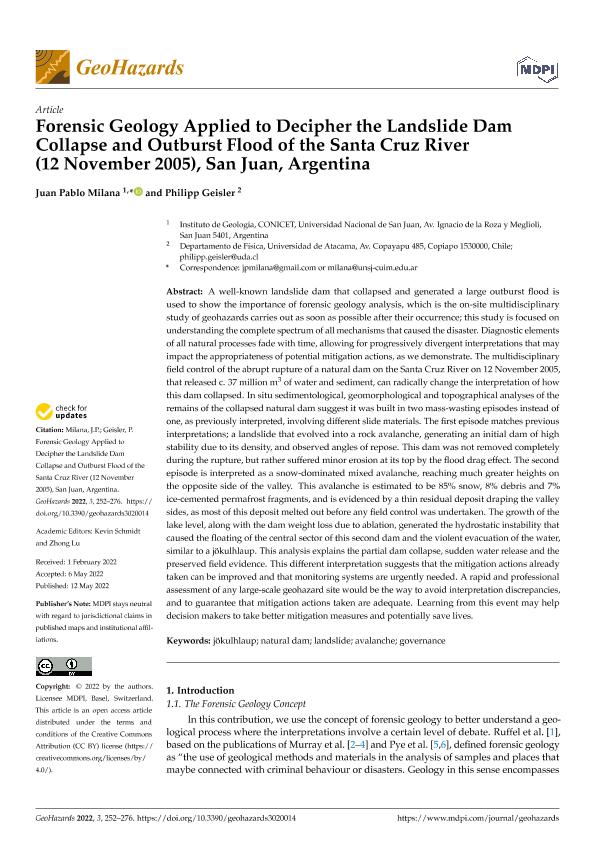Mostrar el registro sencillo del ítem
dc.contributor.author
Milana, Juan Pablo

dc.contributor.author
Geisler, Philipp
dc.date.available
2023-07-25T10:45:29Z
dc.date.issued
2022-02
dc.identifier.citation
Milana, Juan Pablo; Geisler, Philipp; Forensic Geology Applied to Decipher the Landslide Dam Collapse and Outburst Flood of the Santa Cruz River (12 November 2005), San Juan, Argentina; MDPI; Geohazards; 3; 2; 2-2022; 252-276
dc.identifier.issn
2624-795X
dc.identifier.uri
http://hdl.handle.net/11336/205148
dc.description.abstract
A well-known landslide dam that collapsed and generated a large outburst flood is used to show the importance of forensic geology analysis, which is the on-site multidisciplinary study of geohazards carries out as soon as possible after their occurrence; this study is focused on understanding the complete spectrum of all mechanisms that caused the disaster. Diagnostic elements of all natural processes fade with time, allowing for progressively divergent interpretations that may impact the appropriateness of potential mitigation actions, as we demonstrate. The multidisciplinary field control of the abrupt rupture of a natural dam on the Santa Cruz River on 12 November 2005, that released c. 37 million m3 of water and sediment, can radically change the interpretation of how this dam collapsed. In situ sedimentological, geomorphological and topographical analyses of the remains of the collapsed natural dam suggest it was built in two mass-wasting episodes instead of one, as previously interpreted, involving different slide materials. The first episode matches previous interpretations; a landslide that evolved into a rock avalanche, generating an initial dam of high stability due to its density, and observed angles of repose. This dam was not removed completely during the rupture, but rather suffered minor erosion at its top by the flood drag effect. The second episode is interpreted as a snow-dominated mixed avalanche, reaching much greater heights on the opposite side of the valley. This avalanche is estimated to be 85% snow, 8% debris and 7% ice-cemented permafrost fragments, and is evidenced by a thin residual deposit draping the valley sides, as most of this deposit melted out before any field control was undertaken. The growth of the lake level, along with the dam weight loss due to ablation, generated the hydrostatic instability that caused the floating of the central sector of this second dam and the violent evacuation of the water, similar to a jökulhlaup. This analysis explains the partial dam collapse, sudden water release and the preserved field evidence. This different interpretation suggests that the mitigation actions already taken can be improved and that monitoring systems are urgently needed. A rapid and professional assessment of any large-scale geohazard site would be the way to avoid interpretation discrepancies, and to guarantee that mitigation actions taken are adequate. Learning from this event may help decision makers to take better mitigation measures and potentially save lives.
dc.format
application/pdf
dc.language.iso
eng
dc.publisher
MDPI
dc.rights
info:eu-repo/semantics/openAccess
dc.rights.uri
https://creativecommons.org/licenses/by/2.5/ar/
dc.subject
JÖKULHLAUP
dc.subject
LANDSLIDE
dc.subject
NATURAL DAM
dc.subject
GOVERNANCE
dc.subject.classification
Geociencias multidisciplinaria

dc.subject.classification
Ciencias de la Tierra y relacionadas con el Medio Ambiente

dc.subject.classification
CIENCIAS NATURALES Y EXACTAS

dc.title
Forensic Geology Applied to Decipher the Landslide Dam Collapse and Outburst Flood of the Santa Cruz River (12 November 2005), San Juan, Argentina
dc.type
info:eu-repo/semantics/article
dc.type
info:ar-repo/semantics/artículo
dc.type
info:eu-repo/semantics/publishedVersion
dc.date.updated
2023-07-06T11:11:34Z
dc.journal.volume
3
dc.journal.number
2
dc.journal.pagination
252-276
dc.journal.pais
Suiza

dc.journal.ciudad
Basel
dc.description.fil
Fil: Milana, Juan Pablo. Consejo Nacional de Investigaciones Científicas y Técnicas. Centro Científico Tecnológico Conicet - San Juan. Centro de Investigaciones de la Geosfera y Biosfera. Universidad Nacional de San Juan. Facultad de Ciencias Exactas Físicas y Naturales. Centro de Investigaciones de la Geosfera y Biosfera; Argentina
dc.description.fil
Fil: Geisler, Philipp. Universidad de Atacama; Chile
dc.journal.title
Geohazards
dc.relation.alternativeid
info:eu-repo/semantics/altIdentifier/doi/http://dx.doi.org/ 10.3390/geohazards3020014
Archivos asociados
